Our nation’s capital draws all sorts of people and hosts jobs of all kinds. From tollbooth workers to filmmakers and congressmen, just about every career path is found in the city. And while many work in the city, they choose to live right outside it. They raise families, walk their pets, exercise and go to the dentist all here in our own backyard. That’s right, even the top dogs have to face the dreaded dental chair sometime. So where do these writers, models and other notables in our community choose to have work done on their pearly whites?
Northern Virginia Magazine conducted a Dental Survey of the area, and here’s what we found out.
Text by Lynn Norusis, Jacqueline Quattrocchi and Julia Winkler
Smiles in the Spotlight
NoVA’s household faces don’t trust their teeth to just anyone
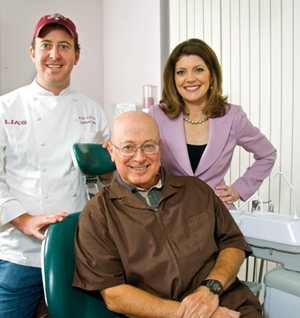
Geoff Tracy: Restauranteur
When your signature uniform is a snowy chef’s jacket, even the slightest discoloration of your pearly whites becomes conspicuous. The first to admit it? Geoff Tracy, owner and overseer of the Chef Geoff’s dining chain that recently carved out a niche for itself in a snug crook of Tysons Corner.
“With all the little promotions I do, it’s important to have at least fairly decent white teeth,” Tracy says. “I don’t think Photoshop can take care of all the mistakes.”
For those, he turns to Dr. Ronald Silverman of Alexandria, a dentist initially referred to Tracy by his mother-in-law and who Tracy’s now been seeing on the regular the past nine years.
“Obviously, I mean, Dr. Silverman is kind of like a friend, so it’s a relationship you develop, and a good, strong relationship,” Tracy says. “And, I always get my appointment times.”
Norah O’Donnell: MSNBC chief Washington Correspondent
The importance of dental health scales new heights when you’re the voice and face of national news. “I certainly cannot do the job that I do with poor dental health, with a black tooth in front,” says Silverman client and Tracy’s wife, MSNBC correspondent Norah O’Donnell.
For that reason, she depends on personal referrals from a pair of reliable sources: her parents. Silverman knows O’Donnell’s father from serving together in the military. “I think word of mouth is a really powerful recommendation with any doctor,” says the newsperson, adding that her mother made certain O’Donnell saw the inside of a dentist’s office on a six-month basis growing up. “You ask people you trust who they like. If it’s a friendly, timely service you’ll continue to use the same place.”
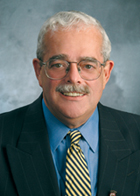
Rep. Gerald Connolly from Virginia’s 11th District
The local congressman received his dental chair wakeup call in the form of side-by-side root canals—required as a result of a weakened immune system from lengthy flights and immunization shots from a work-related visit to Afghanistan. Connolly had Dr. Jim Snyder of Alexandria perform the work, he says, because “If I see a needle I start to get woozy. I won’t see a dentist who doesn’t help calm me down.”
In the midst of a nationwide health care debate, Connolly points to dental health as a major component of plans. “A 12-year-old boy from this area had a dental infection that was left untreated because the mother didn’t have medical insurance. And he died. It was a direct root to brain. … So how important is dental health? Well, without it, it’s life-threatening.”

Gerald Gordon: president of the Fairfax County Economic Development Authority
One of the first faces potential business owners see when they seek out Fairfax as a base is Gerald Gordon, president of the Fairfax County Economic Development Authority. To keep his smile as a welcoming first impression Gordon goes to Dr. William Thomas in Springfield. “They are very personable,” he says. “To be honest, good or bad teeth are not going to break me, but it’s all about comfort.”
Ken Harvey: Former Redskins Linebacker
After recording 89 sacks in 164 games throughout his NFL career, former Redskins linebacker Ken Harvey has surely put a lot of pressure on his body and his mouth. But while it’s important to take care of your teeth for health purposes, appearance does play a role.
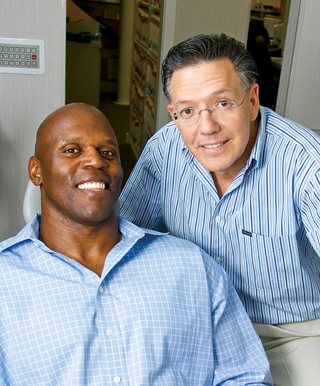
“Regardless of what you say, you are judged in some ways by your appearance,” admits Harvey. “You showing you take care of your teeth is like showing you care. Because of my size, people are sometimes afraid. A nice friendly smile goes a long way in disarming people.”
To get that winning smile Harvey leaves the care of his teeth to Dr. Barry Rudolph in Vienna, the Washington Redskins team dentist from 1984 until 1996.
“Dr. Rudolph and his staff care about you like you are family,” says Harvey. “They go the extra length to make sure you are comfortable and make you feel like you are of high value.
“I figured once I stopped playing football things would change but I realize that he treats all his clients that way, I was no [one] special. It was something that he did normally.”
Marty Russo: Former Illinois Congressman
Former Illinois Congressman, Marty Russo, says his smile makes him “fun, happy and easy to deal with,” especially at work. He found Dr. DeWitt 10 years ago after a buddy who worked for then-Sen. Biden, suggested DeWitt to Russo’s son, Tony.
He describes DeWitt as “the ultimate professional,” adding: “It’s a fun place to go—most people don’t think a dentist is fun, but going to see him is. And, he’s the best guy to numb your jaw.”
“As a kid, I hated dentists,” Russo says. “Dentists in those ages were ‘Hey, get in there, kiddo, I gotta pull your tooth,’ there was no talking to you, making you feel comfortable. When you go [to DeWitt’s] it’s always pleasant.”
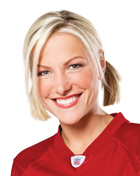
Lindsay Czarniak: NBC 4’s sports anchor
Whether it’s bringing us the latest scores of D.C. United, relaying the double-plays of the Nats or following her favorite team, the Skins, NBC 4’s sports anchor Lindsay Czarniak keeps us up to date on the area’s teams—all while spotlighting her pearly whites.
“Cosmetically, you make sure you look good,” says Czarniak. But her reasons for choosing Alexandria’s Dr. Quang Tran as her dentist for more than four years is not only for the great smile he helps her keep up, it’s “because I’ve been through a lot with him.” Not a fan of needles, by any means, Czarniak is put at ease in Tran’s chair. “I found him through my family, and I just loved him.”
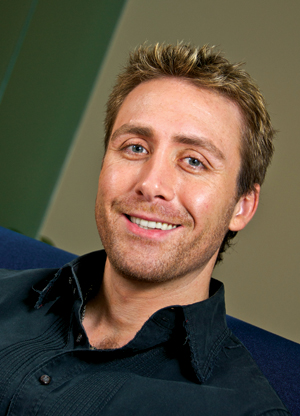
Phillippe Cousteau: correspondent for the Discovery Channel and for Planet Green
If you watch Discovery Channel or Planet Green you have probably caught sight of Philippe Cousteau. Grandson of Jacques Cousteau, Philippe brings environment and conservation education into the homes of people around the world with his captivating smile with help from McLean dentist Dr. H.R. Makarita.
“[A good smile is] critical,” Cousteau says, “that’s why I’ve stayed with the doc. He’s such a great guy. Everybody there had just a good vibe, we just talk about traveling, and he sits and talks to me. Other places are sterile, orderly, get in and get out.”
For five years Cousteau has stayed with Makarita, whose services go above and beyond keeping his smile healthy and putting him at ease.
“He’s not just going to get your teeth clean. From a cosmetic dentistry perspective he’s amazing; [but] from various sporting activities I’ve chipped my teeth, knocked teeth out, and he’s been great.”
Not Just ‘Fill & Drill’
Did you know your teeth could be causing your headaches?
For decades, Sterling resident Daniel Bonner was living with debilitating migraines—taking at least nine Excedrin and one, sometimes two, Imitrex a day. “I had to deal with it because I had to work,” he says.
It started in 1976, when Bonner was involved in an auto accident. The migraines followed, at first only once or twice a month. But in 2005 the onslaught of pain began daily—little did he know it was his teeth that were causing the problem.
“My daughter-in-law, a dentist, went to a conference and met Dr. [Chong] Lee,” recalls Bonner. She informed Bonner of the work Lee was doing with TMJ (Temporomandibular Joint disorder), sufferers of which experience pain in the head or neck that is potentially caused by bite problems.
“I was willing to do anything,” says Bonner, so he immediately scheduled an appointment with Lee, of Galleria Dental Aesthetics in McLean, and “within five minutes he said he could help me.”
To treat Bonner, Lee took a neuromuscular approach, which uses electronic stimulation to relax the muscles in the mouth, allowing him to find the right balance for a patient’s bite, or “finding the position where the brain sees the muscle as being happy,” Lee explains.
Once the correct position is found, a custom plastic mouthpiece is made. After a prescribed amount of time the dentist will then know if the correct placement has in fact been found, based on the levels of comfort to the patient, and the patient can move forward with dental treatment to permanently adjust the bite into the correct position.
Through the three-month process of realigning his bite through the neuromuscular approach, Bonner is now living almost migraine-free. He opted to keep the mouthpiece as opposed to moving forward with permanent adjustments.
Dr. Sherry Kazerooni’s patient, Richard Roscitt, also suffered from headaches due to an offset bite but opted to go forward with a full mouth rejuvenation.
“He actually had headaches daily and I kept telling him he had grinded his teeth down,” says the McLean-based dentist.
“I have to make sure before I do dental work that the headache is gone so I put [patients] in an appliance called Orthotic,” Kazerooni explains. “It repositions the teeth where the muscles are relaxed, so basically once they are pain-free then … I restored all of the upper and lower arch. In one visit, I did the prep work. A couple weeks later I brought him back and did all the dental work.”
“If you’ve ever seen anyone who does that, their teeth are shorter, the whole bite collapses, and that’s where the headaches and shoulder pain [come from],” she says.
In addition to wanting a beautiful smile, former European runway and photo shoot model, Orsolya Keegan, began seeking dental treatment for intense headaches and muscle pain she’d experienced her whole life. The pain, she says, made her grumpy, moody and even put her in the emergency room a few times. After interviewing several dentists in the area, she settled on Dr. Gordon Rye.
In January of 2007 Keegan began treatment, which included orthotics—to realign Keegan’s jaw and relieve the severe headaches—lasers to reshape her gums, porcelain crowns and veneers. Wax models and photography were also used. Six months later, in July of 2007, Keegan’s treatment was completed. “I look better, I feel better. I feel very attractive and very young,” Keegan says.
While the neuromuscular approach is one that has been gaining steam in the past few decades, Dr. Gregg Helvey of Middleburg says it is not the only way to deal with headache pain caused by an unbalanced bite.
An assistant professor at Virginia Commonwealth University School of Dentistry, Helvey says the traditional methods of treating TMJ disorder are just as reliable. Called loading the jaw, the traditional technique involves the dentist manually repositioning the ball and socket joint into a comfortable position for the patient. “How do you ascertain this?” Helvey rhetorically asks. “If the patient doesn’t feel pain, then you are there.”
Helvey says that TMJ is not always associated with a person’s bite, but advises that if you have regular headaches, when you go to the dentist, ask for a TMJ exam.
What is the biggest concern patients have these days?
“They want to be comfortable with the person that they’re working with, and they want to have confidence in the person’s abilities. We spend a lot of time when they first come in to get to know them and let them get to know us and form a level of trust so we can work together to improve their dental health.”—Dr. Todd Casey, General Dentistry
“Cost and looks, and they’re worried about whether or not insurance will cover things. And I think the fear factor is big, I think people often are scared.”—Dr. Mary Catherine Dvorak, General Dentistry
Right now, there are a couple of issues that we have. There are financial concerns for more elective procedures—implants, grafting procedures, more aesthetic-type procedures. So that’s one thing, and that would be the main thing. … Since our clients are referred to us by their own dentists, they know what the issue is when they come to us, have an understanding of what’s going on. We can sedate them, completely putting them on anesthesia. We’re lucky enough to be trained to put the patient to sleep—that’s one thing that’s very important—so the only pain and discomfort to deal with comes afterward.—Dr. Hugh Zadeh, Oral
Well, there are two. Either number one, How quickly can my implants be done? And number two, How sore and swollen will I be after my wisdom teeth are out? There’s a whole spectrum: Some are calling all their friends the next day and telling them what a bunch of weenies they all are, others are looking like a blowfish for a week.—Dr. Theodore Corcoran, Oral
“Whether they’re going to lose their teeth or not, because of disease, or how they can restore dental health. When they come to see me they’re usually referred by a dentist for a specific reason, either they need an implant or something.”—Dr. Lillian Carpio, Peridontics
“There are a few things here they’re concerned about. In these economic times here, how much is it going to cost? Also, just, is it going to hurt? There’s nothing novel about that, but it’s still a major concern that patients have. Many people are anxious before coming in, so the new trend these days deals with the levels of sedation, making that available to patients so that it’s not a reason to avoid healthcare. If anything, the economy has given them a reason even moreso to avoid pain.”—Dr. Benjamin Watkins, Prosthodontics
“Pain, people are concerned about having pain when they come to have the root canal done. And we use a laser to clean and sterilize the inside of canals so that we have fewer complaints for pain and fewer reasons for residual pain.”—Dr. Mary Choby, Endodontics
“For me personally I would say that the main concern people have had is that they’ve been to another dentist who was unable to complete treatment or didn’t feel comfortable because it was a child. As for new patients it’s mainly just routine preventive care.”—Dr. Dawn Crandall, Pediatric Dentistry
Top Dentists Survey Results >>
(November 2009)



